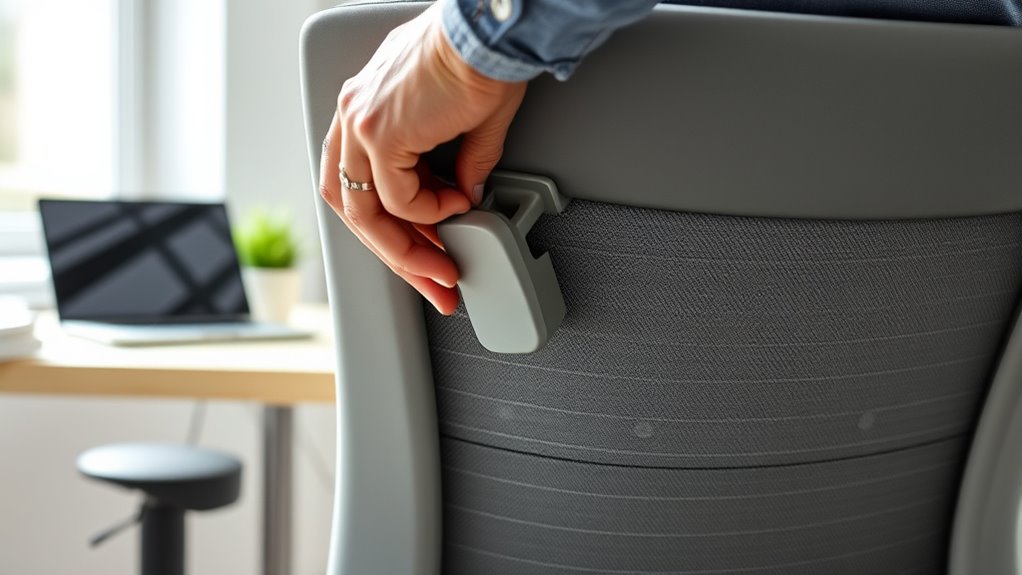To say goodbye to back pain, start by adjusting your chair height so your feet are flat and knees form a 90-degree angle. Support your lower back with lumbar support or cushions, and position armrests for relaxed shoulders. Tilt the chair slightly backward for comfort and keep your monitor at eye level to avoid neck strain. Making these simple adjustments will improve your posture; keep going to discover more tips for lasting relief.
Key Takeaways
- Set your chair height so feet are flat on the floor with knees at a 90-degree angle.
- Use lumbar support to fill your lower back’s natural curve without squeezing.
- Adjust armrests to keep shoulders relaxed and elbows at a comfortable 90-degree angle.
- Tilt the chair slightly backward to reduce lower back pressure and promote comfort.
- Position your monitor at eye level and take regular breaks to stretch and reset your posture.

If you often experience back pain at work, adjusting your office chair can make a significant difference. The right setup helps support your spine and promotes proper posture, reducing strain and discomfort. One of the easiest ways to improve your sitting position is by incorporating ergonomic accessories. These accessories, such as lumbar support cushions or adjustable footrests, are designed to complement your chair and provide additional support where you need it most. They can help fill gaps that cause slouching or uneven weight distribution, encouraging better alignment.
Adjusting your office chair isn’t just about comfort; it’s about posture correction. Start by setting the chair height so your feet are flat on the floor, with your knees roughly at a 90-degree angle. This position minimizes pressure on your lower back and encourages a natural curve in your spine. If your feet don’t reach the floor comfortably, use an ergonomic footrest to maintain proper leg positioning. Once your feet are supported, adjust the seat depth so there’s a small gap—about two to three inches—between the back of your knees and the edge of the chair. This ensures proper circulation and prevents unnecessary pressure on your thighs.
Set your chair height so feet are flat and knees at 90° for better posture and circulation.
Next, focus on your lumbar support. Many chairs come with built-in lumbar adjustments, but if yours doesn’t, adding a lumbar support cushion can be a game-changer. Position it so it fills in the natural curve of your lower back, providing the support needed to maintain good posture throughout the day. Your back should feel supported but not squeezed. The armrests also play a vital role; adjust them so your shoulders are relaxed and your elbows rest comfortably at your sides, roughly at a 90-degree angle. Proper arm support prevents hunching and shoulder tension.
Finally, tweak the tilt and recline functions to suit your work style. A slight backward tilt can help reduce pressure on your lower back and keep you comfortable during extended periods of sitting. Make sure your monitor is positioned at eye level to prevent neck strain, which often accompanies poor back posture. When you take short breaks, stand up, stretch, and reset your position to avoid staying in the same position for too long. Incorporating AI-powered ergonomic tools can also help you analyze and optimize your sitting posture more effectively.
Frequently Asked Questions
How Often Should I Adjust My Office Chair During the Day?
You should adjust your office chair several times a day, ideally every 30 to 60 minutes, to maintain comfort and proper posture. Use ergonomic accessories to support your back and neck, and tweak your chair height to keep your feet flat on the floor and your knees at a 90-degree angle. Regular adjustments prevent strain, improve focus, and help avoid back pain throughout your workday.
Can Proper Chair Adjustment Prevent Long-Term Back Issues?
Proper chair adjustment can definitely prevent long-term back issues. When you focus on posture correction through ergonomic settings, you reduce strain on your spine. Regularly adjusting your chair guarantees proper support, which helps prevent back pain over time. By maintaining correct alignment, you promote better back health and avoid future discomfort. So, yes, proper chair adjustment is a key step in back pain prevention and sustaining good posture during work.
What Are Signs My Office Chair Is Not Properly Adjusted?
If your office chair isn’t properly adjusted, you might notice signs like persistent back pain, discomfort after long sitting periods, or poor posture correction. You may also experience numbness or tingling in your legs. Regular chair maintenance helps guarantee proper alignment, reducing strain. Pay attention to your body’s signals—if discomfort persists, it’s time to recheck your chair’s height, lumbar support, and angles to stay comfortable and avoid future issues.
Are Ergonomic Chairs More Effective Than Regular Office Chairs?
Imagine your workspace as a tailored suit—ergonomic chairs offer the same perfect fit. They provide enhanced ergonomic benefits, supporting your body’s natural curves and reducing strain. With chair customization options, you can fine-tune your posture for maximum comfort. Compared to regular office chairs, ergonomic ones are more effective in preventing pain and boosting productivity. Investing in one means prioritizing your well-being, turning a simple chair into a personalized health ally.
How Do I Know if My Chair Supports Proper Lumbar Alignment?
You’ll know your chair supports proper lumbar alignment if it provides good lumbar support that contours to your lower back. Check if the lumbar support is adjustable to match your spine’s natural curve, helping maintain correct posture alignment. When sitting, your lower back should feel supported without pressure or discomfort. If your chair lacks these features, consider adding lumbar cushions or replacing it with one designed for ideal posture support.
Conclusion
Now that you know how to adjust your office chair like a pro, you’re all set to beat back pain and stay comfortable. Remember, a little tweak here and there can make all the difference. Don’t just sit and suffer—take action and stay proactive about your posture. After all, an ounce of prevention is worth a pound of cure. Keep these tips in mind, and you’ll be feeling better in no time!









